Research on Ultra‐Connectivity in 6G Wireless Networks at Informatics Institute
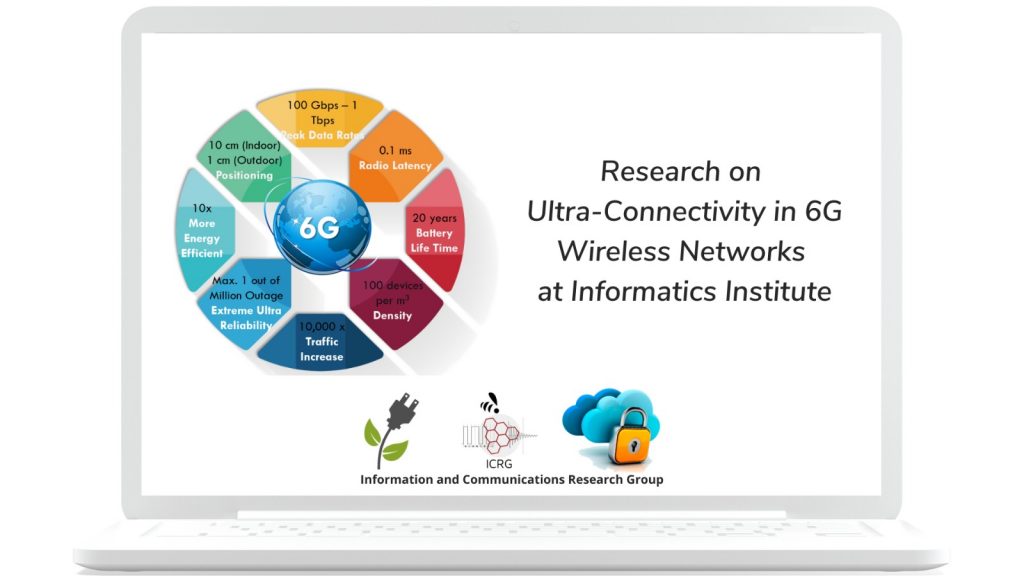
Information and Communications Research Group (ICRG) at Informatics Institute conducts academic and industrial research projects for beyond-5G and 6G next-generation communication networks. Along with that, ICRG publishes in the fields of green communications, NOMA, mobile edge computing, IRS, FSO, and vehicular communications in journals of high impact factors.
| We are heading toward a future where everything is entirely automated and managed remotely. The fast development of new applications like artificial intelligence (AI), virtual reality, three-dimensional (3D) media, and the internet of things (IoT) has led to a vast amount of traffic. Autonomous systems are gaining popularity in a variety of fields, including industry, health, transportation, seas, and space. Millions of sensors will be implanted in cities, automobiles, houses, industries, toys, and other settings to give a smart life and automated systems. As a result, these apps will demand a high data throughput as well as reliable connectivity. Fifth-generation (5G) wireless networks have already been installed in several regions of the world. 5G networks will be unable to create a fully automated and intelligent network that offers everything as a service and a fully immersive experience. To overcome the limitations of 5G for obstacles, a sixth-generation (6G) wireless technology with additional appealing characteristics will be required. The convergence of all previous aspects, such as network densification, high throughput, high dependability, low energy consumption, and huge connection, will be the major drivers of 6G. The 6G system would also carry on the previous generations’ tendencies, which included new services and the introduction of new technology. AI, smart wearables, implants, autonomous vehicles, computing reality gadgets, sensing, and 3D mapping are among the new offerings. The capacity to handle large amounts of data and very high-data-rate connection per device is the most crucial need for 6G wireless networks. In other words, massive connection, low latency, high data rates, extensive coverage, and great dependability are expected to be possible with 6G wireless networks shown in Figure 1. |

| ICRG Group Our group in the informatics institute mainly focuses on the cutting-edge research field of 6G. Several topics on the 6G fields are given in Figure 1 such as battery lifetime, latency, energy efficiency. Along with that, green communication, NOMA, edge computing, IRS, FSO, non-terrestrial networks and vehicular communications are involved in the scope area of our research topics (hyper-link: https://icrg.itu.edu.tr/research/). Being a part of the Informatics Institute, ICRG has 15+ active researchers including post-doctoral research associates, Ph.D./MS students, and undergraduate students, as well as collaborators from several different universities. More information on our group is provided at https://icrg.itu.edu.tr. During this year, our group members have published several papers. The published papers in 2022 are listed in the following: |
| H. Alakoca, M. Namdar, S. Aldirmaz-Colak, M. Basaran, A. Basgumus, L. Durak-Ata, and H. Yanikomeroglu, “Metasurface Manipulation Attacks: Potential Security Threats of RIS-Aided 6G Communications,” in IEEE Communications Magazine, doi: 10.1109/MCOM.005.2200162. H. Alakoca, M. Babaei, L. Durak-Ata and E. Basar, “RIS-Empowered Non-Linear Energy Harvesting Communications Over Nakagami-m Channels,” in IEEE Communications Letters, vol. 26, no. 9, pp. 2215-2219, Sept. 2022, doi: 10.1109/LCOMM.2022.3182482. B. Atan, M. Basaran, N. Calik, S. Tedik-Basaran, G. Akkuzu, L. Durak-Ata, “AI-empowered fast task execution decision for delay-sensitive IoT applications in edge computing networks,” IEEE Access (Early Access, available as of 23 Dec. 2022, DOI: 10.1109/ACCESS.2022.3232073. M. Babaei, L. Durak-Ata and Ü. Aygölü, “Performance Analysis of Dual-Hop AF Relaying with Nonlinear/Linear Energy Harvesting”, Sensors, 2022, doi: 10.3390/s22165987. M. Babaei, L. Durak-Ata and Ü. Aygölü, “New Practical Nonlinear Energy-Harvesting Models for Wireless-Powered Communications”, Wireless Communications and Mobile Computing, 2022, doi: 10.1155/2022/6534754. H. Alakoca, and L. Durak-Ata, “Secrecy Performance of RIS-enabled Linear Interference Alignment Multi-User MIMO Network ,” 30th Telecommunications forum TELFOR, 2022 Note: All published papers can be found from the link: https://icrg.itu.edu.tr/publications/ |
| Projects: Since 2019, our group has applied and granted for several projects from different organizations. Some of our sponsors and partners are Presidency of Defence Industries, İTÜ Vodafone Future Lab, İTÜNOVA TTO, Air Inc., ARMERKOM, and ANDASİS. Until now, sixteen projects have been completed and currently, three active projects are available where the details of all the active and completed projects can be found in https://icrg.itu.edu.tr/projects/. Additionally, the last accepted and current project is given below: |
| The Scientific and Technological Research Council of Turkey (TUBITAK) in the context of the 1001 project, “Ultra-Connectivity for 6G Wireless Communications: UAV and Intelligent Reflective Surface Enabled Heterogeneous Network Design”. |
Here, we aim to reveal a high-performance vertical HetNet (VhetNet) with unmanned aerial vehicles (UAVs) and intelligent reflecting surfaces (IRS) considering physical layer security. In the context of 6G, networks are anticipated to include not just terrestrial but also flyable network pieces, and hence infrastructure functionality for both terrestrial and non-terrestrial networks would differ significantly. Non-terrestrial networks will be made up of a variety of vertical parts, including satellites and flying base stations equipped with UAVs BSs. In contrast to fixed-position terrestrial BSs, wireless networks utilizing UAVs can ensure communication continuity in unanticipated extreme conditions by working autonomously in hard-to-reach places.
In heterogeneous networks (HetNets), intelligent reflecting surfaces (IRS), which are designed as next-generation transceivers, come into focus with low power consumption and secure communication characteristics. In the near future, these communication nodes, which may function as either BSs or users in a network connection, are expected to become increasingly widespread.
A reliable, energy-efficient, and effective vertical HetNet (VHetNet) architecture is suggested in this project proposal. In the terrestrial HetNet structure, a realistic Poisson point process-based configuration will be built for this purpose. Its goal is to use UAV and IRS to reveal the VHetNet’s energy and communication efficiency, as well as physical layer security, in terms of trajectory, position, and altitude depicted in Figure 2.
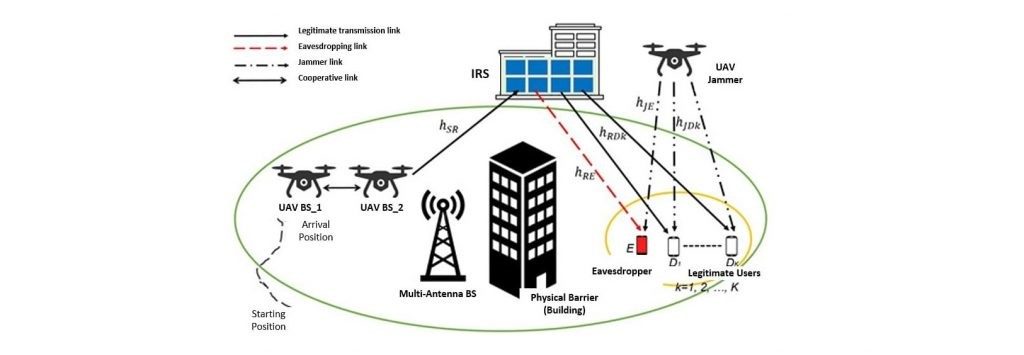
| Physical layer security of future smart radio environments, Funded by Istanbul Technical University Scientific Research Projects, İTÜ BAP, Turkey, Project Grant No. MDK-2022-43782. |
| Secure communications of RIS-empowered networks are critical for next-generation wireless networks. In the project, novel RIS-empowered security solutions are investigated using theoretical analyzes and optimization methods. In addition, new PLS solutions such as artificial intelligence (AI) based optimization are aimed at being used appropriately for integration into the RIS-empowered security solutions. Reconfigurable intelligent surfaces (RIS) or smart radio environments are considered promising approaches to control the electromagnetic environment for the first time by communication engineering, unlike traditional wireless communication techniques. In addition, ensuring RIS security, especially in the integration of new-generation communication systems, is an important open point in the literature. This situation can be especially dangerous for unwanted and illegal access, mobile service providers, subscribers, and governments. It is impossible to ignore the increasing vertical communication assistance in broadband mobile networks. Using smart surfaces with UAV or satellite networks can be even more detrimental, due to the lack of secure communication systems. Physical layer security (PLS) is a promising solution for upgrading the security framework for legitimate users as it reduces the overhead of complex cryptographic encryption while increasing data speeds. As a result, examining energy/spectral efficiency and physical layer security is the primary principle for the design and performance of RIS-empowered applications. The main scope of this project has been identified as the effective use of RIS-empowered networks with security applications, which are currently the main open research areas in the leading literature. In theory, new RIS-enabled security approaches will be explored. In the next step, it is planned to continue the theoretical approaches in these additive techniques as closed-form expression or optimization methods. On the other hand, new PLS solutions such as artificial intelligence (AI) based optimization are aimed to be used appropriately for integration into RIS-empowered framework. Energy Efficient Base Station Deployment in Vertical Heterogeneous Networks; Funded by Istanbul Technical University Scientific Research Projects, İTÜ BAP, Turkey, Project Grant No. MDK-2022-43765. Vertical heterogeneous networks are a promising approach to increase the coverage and spectral efficiency of the network. However, the increase in the heterogeneity of the network topology causes costly energy consumption. It also brings difficulties in the analysis of the network model. In this project, we aim to use mathematical models such as stochastic geometry models for deploying BSs with the technologies of UAV and Reconfigurable Intelligent Surfaces. Thus, interference and fading effects in positioning will be minimized and it will also facilitate analytical inferences for evaluating the energy efficiency of the network system. |

| Research topic: In the context of the 6G research field, we have done several types of research. A brief illustration of some research works which have been accepted to journals/conferences has been provided in the following. |
Energy Efficient and Secure Reconfigurable Intelligent Surfaces:
In the physical layer, reconfigurable intelligent surfaces (RIS) are the innovative element for advancing service quality and quality of experience. However, it is essential to ensure secure communications through RIS-enabling networks due to the interconnected potential for communications in next-generation wireless networks considering the information and communications technology (ICT) agenda. On the other hand, PLS-enhanced solutions are the most prominent for 6G communication networks that satisfy cyber-physical system requirements instead of generic methods. Various applications and co-dependencies using RIS-assisted communications have also been possible, such as industrial communications, space communications, body area networks, and interconnected vehicular communications. While the conventional possible threats can be widely found in the literature, covering wireless jamming, spoofing, and eavesdropping, a diverse set of novel potential attacks is presented in this article. Although vertical communication systems are planned to improve secrecy, the secure communications of RIS-enabled networks remain critical for defense and space networks due to the stringent safety requirements. Unintended access could be controlled and coordinated with smart surface integrated vertical communication equipment such as satellites and unmanned aerial vehicles, etc. As PLS-aided solutions for RIS-assisted wireless communications are becoming more and more prominent, guaranteeing high reliability and secrecy, enabling ultra-connectivity, and enhancing end-to-end secure communications network performance should be extensively studied for 6G wireless networks.
| New RF Energy Harvesting Models For Next‐Generation Wireless Communication Systems: Deployment of massive sensor and Internet of Things (IoT) devices in next-generation wireless communication systems reveals energy limitations as one of the challenges. Typically, IoT devices are powered by a battery, which restricts their capacity and working time. Energy harvesting (EH) has been regarded as a promising approach which can increase the life-time of a wireless communication system. In EH, energy is obtained by wind, solar, vibration, etc. Thus, the harvested energy is transformed into electricity and can be used by the desired nodes. However, the aforementioned traditional EH methods are not always available. Additionally, radio frequency (RF) EH has emerged as a key promising technique that enables wireless systems to harvest energy from the incoming signals in the environment. This energy is available as dedicated or ambient energy and can be harvested throughout the whole day. Hence, RF EH can be an effective alternative for empowering battery-free IoT devices, resulting in increased operational time. |
| H. Alakoca, M. Namdar, S. Aldirmaz-Colak, M. Basaran, A. Basgumus, L. Durak-Ata, and H. Yanikomeroglu, “Metasurface Manipulation Attacks: Potential Security Threats of RIS-Aided 6G Communications,” in IEEE Communications Magazine, doi: 10.1109/MCOM.005.2200162. |
The physical layer security (PLS) of reconfigurable intelligent surfaces (RIS) is critical for providing secure and reliable communications in the 6th-generation (6G) wireless systems. This paper contributes to a debate on many aspects of unique vulnerabilities that can arise in the PLS of RIS with malicious attacks on signal processing (SP) in 6G networks. We address and categorize future security threats in RIS-aided networks considering PLS aspects. Metasurface manipulation attacks (MSMA) are based on manipulating metasurface behavior for malicious purposes. In this study, we present the potential hostile activities of MSMA considering the impact of electromagnetic and time-frequency deterioration. In addition, we evaluate various interference-based MSMA and eavesdropping booster-based MSMA (EaB-MSMA), which are novel potential PLS attacks that involve manipulating phase shifting activity with SP on malicious RIS. We also compare performance degradation in the presence of hostile interference-based MSMA through the manipulation of maliciously configured RIS. Additionally, in the EaB-MSMA case, the loss of secrecy capacity is shown to be considerably greater in passive eavesdropping scenarios.
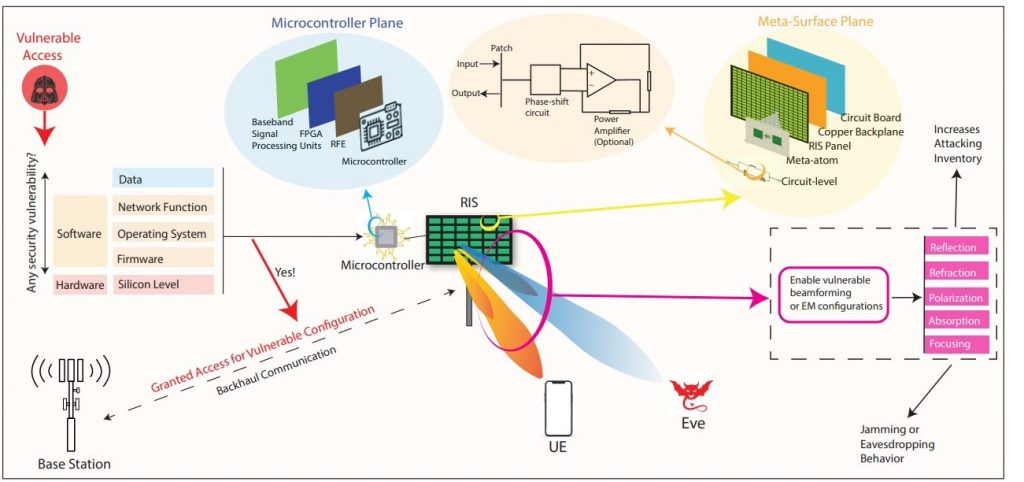
| H. Alakoca, M. Babaei, L. Durak-Ata and E. Basar, “RIS-Empowered Non-Linear Energy Harvesting Communications Over Nakagami-m Channels,” in IEEE Communications Letters, vol. 26, no. 9, pp. 2215-2219, Sept. 2022, doi: 10.1109/LCOMM.2022.3182482. We propose novel reconfigurable-intelligent-surface (RIS)-based energy harvesting (EH) systems with linear EH (L-EH) and non-linear EH (NL-EH) models where channels are exposed to Nakagami- m fading. We also compare two RIS-based EH systems in terms of RIS locations, namely RIS-EH and RIS-information processing (RIS-IP). In the RIS-EH, RIS increases the amount of harvested energy, while in the RIS-IP, RIS is utilized to improve the information processing link. Closed-formed expressions of throughput, outage probability, and average harvested power are derived and confirmed via simulation. The L-EH model overestimates system performance, while the NL-EH model provides a realistic interpretation of EH system design. |
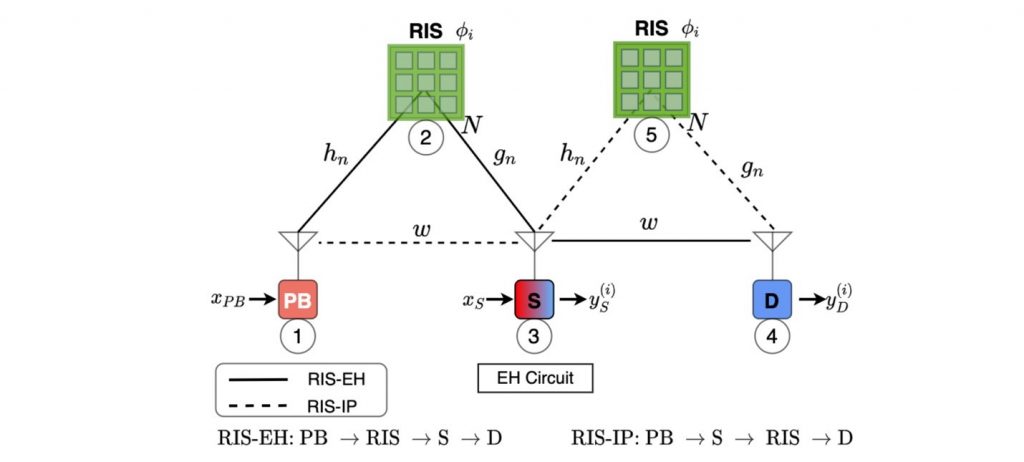
| B. Atan, M. Basaran, N. Calik, S. Tedik-Basaran, G. Akkuzu, L. Durak-Ata, “AI-empowered fast task execution decision for delay-sensitive IoT applications in edge computing networks,” IEEE Access (Early Access, available as of 23 Dec. 2022, DOI: 10.1109/ACCESS.2022.3232073. As the number of smart connected devices increases day by day, a massive amount of tasks are generated by various types of Internet of Things (IoT) devices. Intelligent edge computing is a promising enabler in next-generation wireless networks to execute these tasks on proximate edge servers instead of smart devices. Additionally, regarding the execution of tasks in edge servers, smart devices could provide a low latency environment to the end users. Within this paper, an artificial intelligence (AI)-empowered fast task execution method in heterogeneous IoT applications is proposed to reduce decision latency by taking into account different system parameters such as execution deadline of the task, battery level of devices, channel conditions between mobile devices and edge servers, and edge server capacity. In edge computing scenarios, the number of task requests, resource constraints of edge servers, mobility of connected devices, and energy consumption are the main performance considerations. In this paper, the AI-empowered fast task decision method is proposed to solve the multi-device edge computing task execution problem by formulating it as a multi-class classification problem. The extensive simulation results demonstrate that the proposed framework is extremely fast and precise in decision-making for offloading computation tasks compared to the conventional Lyapunov optimization-based algorithm results by ensuring the guaranteed quality of experience. |
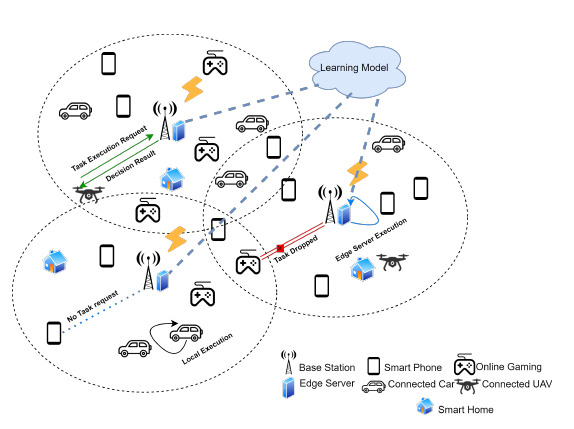
| M. Babaei, L. Durak-Ata and Ü. Aygölü, “Performance Analysis of Dual-Hop AF Relaying with Nonlinear/Linear Energy Harvesting”, Sensors, 2022, doi: 10.3390/s22165987. In the first system model, the performance of a wireless-powered, two-hop, amplify-and-forward relaying system is studied when there is no direct link between the source and the destination. The power-constrained source and relay receive energy from a dedicated power beacon (PB) that broadcasts an energy-bearing signal. For both linear and NL energy harvesting models, theoretical derivations of BEP, outage probability, and throughput expressions are performed. Additionally, Monte Carlo simulations are performed to verify the theoretical results that are presented for various system parameters. The results show how the realistic NL EH model is different from the traditional linear EH model, which overestimates the performance of the system when a large amount of energy is harvested. This results in a misunderstanding of the actual performance of EH systems. However, both models operate similarly and provide appropriate results at low levels of harvested energy. |

| M. Babaei, L. Durak-Ata and Ü. Aygölü, “New Practical Nonlinear Energy-Harvesting Models for Wireless-Powered Communications”, Wireless Communications and Mobile Computing, 2022, doi: 10.1155/2022/6534754. In the second work, the performance of the proposed two novel NL EH models is analyzed in terms of average harvested power, throughput, and BEP. The system comprises a single multi-antenna power-constraint source that transmits its signal to a destination with multiple antennas while harvesting power from a dedicated PB. For a comprehensive analysis of the system, closed-form expressions are derived for Nakagami-m fading channels and the special case of Rayleigh channels. In addition, for existing NL EH models, the simulation results are obtained using the Monte-Carlo method. The results provide a broader picture of EH systems and comprehensively compare the proposed NL EH models to linear, piece-wise linear, and NL EH models available in the literature. As a result, these provide better perspectives on the analysis and design of EH systems. |

| H. Alakoca, and L. Durak-Ata, “Secrecy Performance of RIS-enabled Linear Interference Alignment Multi-User MIMO Network,” 30th Telecommunications forum (TELFOR), 2022. In this study, an reconfigurable intelligent surface (RIS)-enabled linear interference alignment (IA) is examined for multi-user multiple-input multiple-output (MU-MIMO) in a presence of an eavesdropper. Modified precoder and postcoder matrix designs are introduced to minimize interference for legitimate users which is used as ensuring secure communications. According to our findings, the secrecy sum rate of the IA-based RIS-enabled MU-MIMO outperforms that without IA case due to the intensive interference of the communication environment. |

